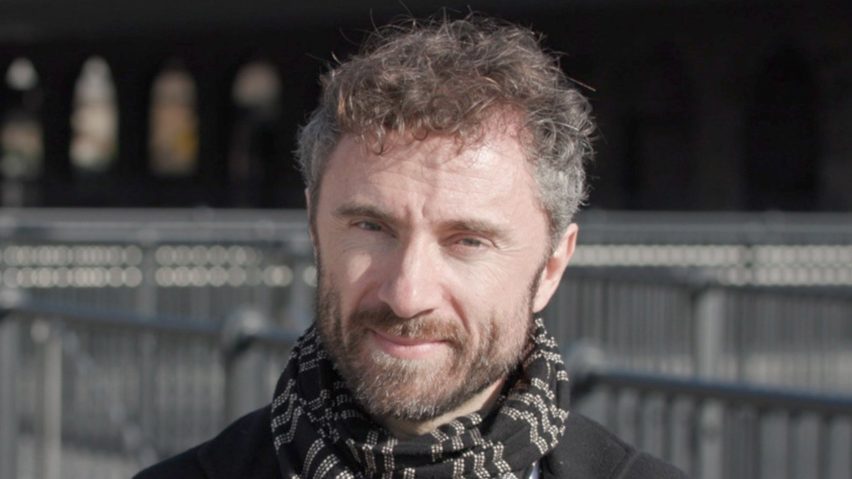
"Trees aren't a novelty" says Thomas Heatherwick
Placing greenery and trees on buildings is not a passing fad, says designer Thomas Heatherwick in this exclusive interview.
Speaking to Dezeen at the unveiling of the Tree of Trees sculpture outside Buckingham Palace, British designer Heatherwick defended the practice of integrating trees and planting into architecture.
"Trees aren't a novelty. They're essential in life," he told Dezeen. "And so I think the architectural world can like to think things are fads but we need water, we need air, we need trees."
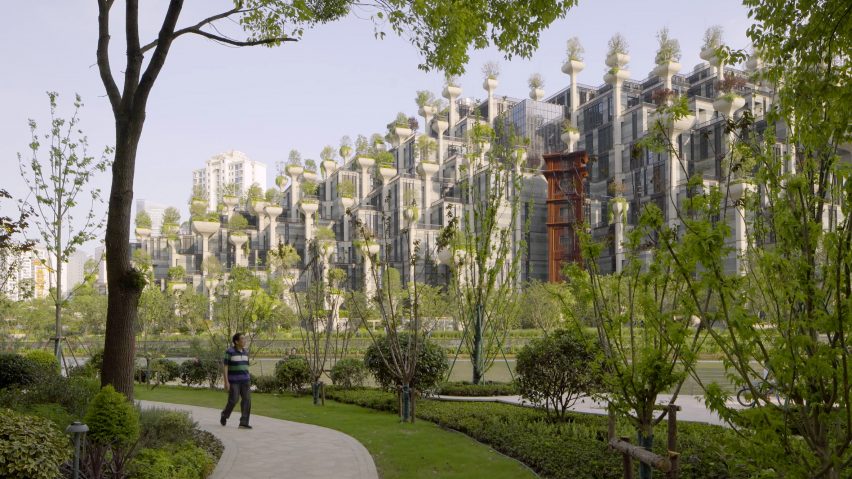
Heatherwick argued that more trees and plants need to be in cities and that major developments provide an opportunity to add more greenery to urban areas.
"There aren't enough trees being built in cities," he explained.
"You go to anywhere where new buildings are being built, and there isn't a sufficient balancing of the natural world."
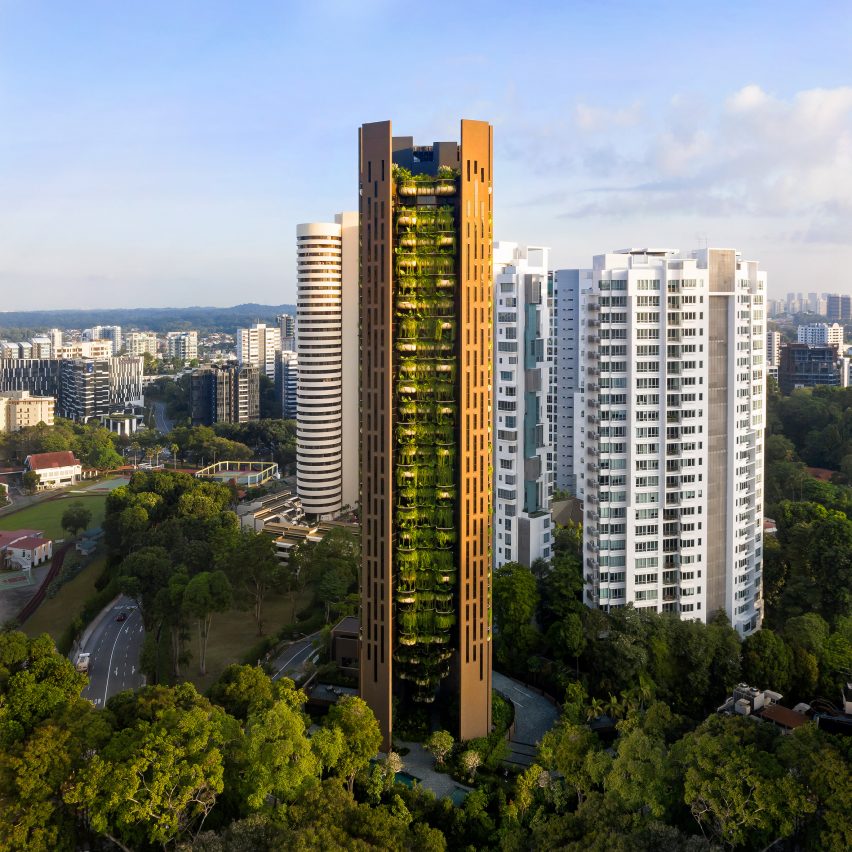
Heatherwick's architecture and design studio Heatherwick Studio has completed several buildings that have included large amounts of planting.
Its recently opened 1,000 Trees project in Shanghai is topped with numerous trees placed in large concrete planters, while the balconies of its Singapore skyscraper are covered in planting.
These projects form part of a wider trend to incorporate large amounts of planting on the exterior of buildings, which Heatherwick believes should be encouraged.
"If you look across lots of our projects, we're integrating nature as much as we possibly can," he said.
"And I think that it would be good for the world around us if more designers and architects balanced the work that they did with the natural world."
Integrating trees into buildings has become increasingly popular since Stefano Boeri completed his seminal Bosco Verticale "vertical forest" skyscraper in Milan in 2014.
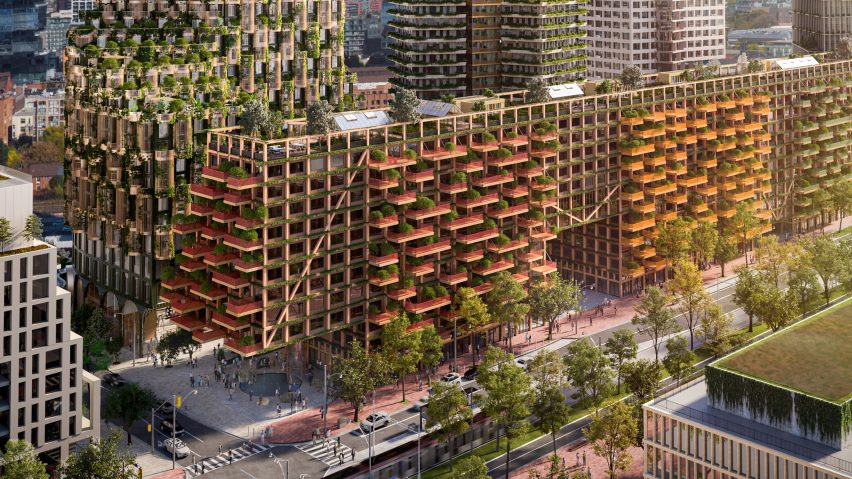
In the past year, Boeri has completed tree-covered skyscrapers in China and the Netherlands, while studios including Kengo Kuma, Adjaye Associates and Foster + Partners have all unveiled major projects that incorporate planting on their facades.
Although tree-covered buildings are a growing phenomenon, many have questioned the sustainable impact of the planting.
In an opinion piece for Dezeen, academic Philip Oldfield described the planting on 1,000 Trees as a "decorative flourish" and calculated that the embodied carbon of its concrete planters was higher than the amount of carbon the trees would absorb.
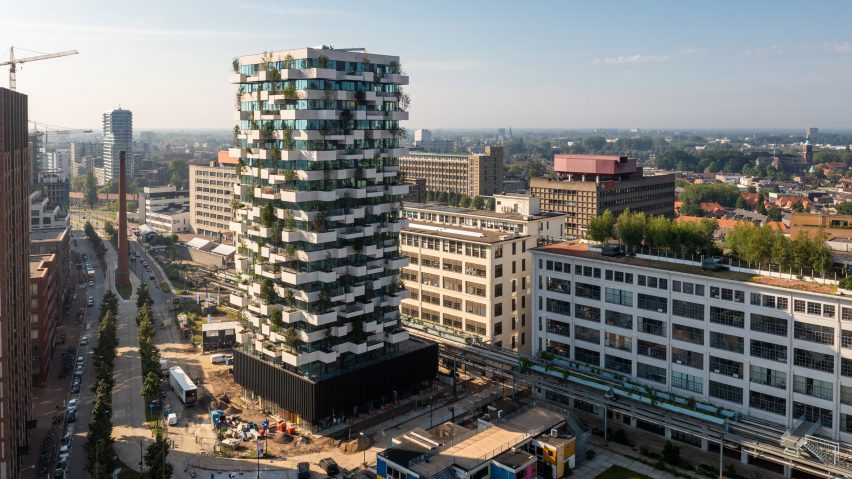
However, Heatherwick does not believe that plant-covered buildings are a "fad".
"It's easy to be snippy and see things as fads," said Heatherwick.
"Because there's banter that goes back and forth. But in real terms, we all respond to places where there is something that is changing throughout the year, which aluminium cladding and precast panels don't do," he continued.
"Something that renews and refreshes, that aluminium panelling and silicone sealants and big pieces of glass don't do."
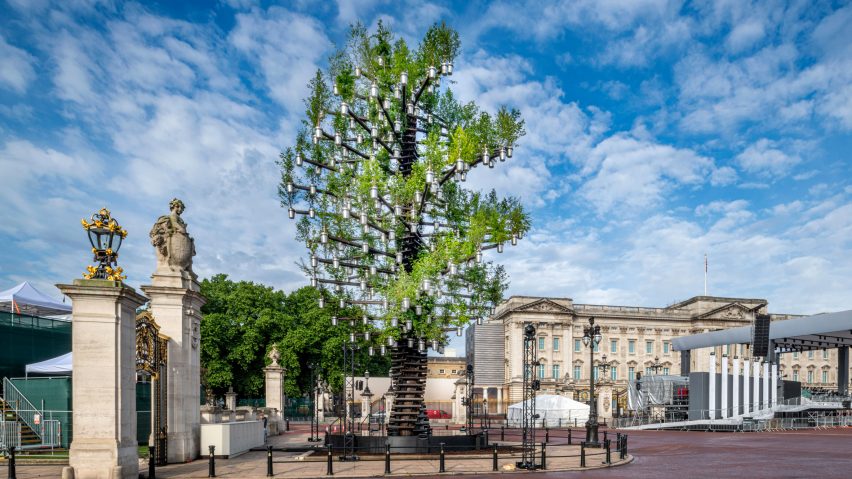
Heatherwick spoke to Dezeen at the unveiling of a 21-metre, tree-like sculpture at Buckingham Palace that was created to draw attention to a UK-wide tree-planting initiative.
The Queen's Green Canopy campaign, which was initiated to mark the Queen's 70-year reign, has seen over a million trees planted in the UK since October.
"Our job was to communicate this amazing initiative, highlighting that trees are the superheroes of our cities and towns," said Heatherwick.
"And every architect and designer knows that our cities and towns would be hugely impoverished experiences if we don't support the balancing of the built environment with the natural environment," he continued.
"And so the something that is trying to shine a light on that is important and worth doing."
Read on for the interview with Thomas Heatherwick:
Tom Ravenscroft: Do we need more trees in cities?
Thomas Heatherwick: Trees aren't a novelty. They're essential in life. And so I think the architectural world can like to think things are fads but we need water, we need air, we need trees.
Tom Ravenscroft: But this tree is kind of a novelty.
Thomas Heatherwick: Well, this tree is highlighting an initiative. This isn't a permanent project, it is a temporary project, drawing attention to planting millions of trees across the country. So it's deliberately creating a focal moment that highlights something.
Tom Ravenscroft: So it's deliberately playful to capture people's attention?
Thomas Heatherwick: The job was to create a communication device that will emphasise an initiative.
If we brought a normal tree, no one's going to look at it because they normally look at trees. So you have to do something extraordinary. Otherwise, it wouldn't do the job. So we would be failing as designers if we didn't do something that captures people's engagement and provokes questions.
Tom Ravenscroft: People have asked: why not plant a normal tree?
Thomas Heatherwick: In a sense, that's a good question. Because, in a sense, planting trees is a banal thing.
Yet trees are simultaneously the superheroes of our towns and cities. We've learned more than ever that biodiversity isn't just a nice thing; it's essential for our mental health.
When you have nature within cities – the reductions in crime and antisocial behaviour, the reduction in time for people to get to heal is significantly improved by proximity to trees and nature. How do you draw attention to something we all already know already? You give it a twist somehow.
I mean, literally, this behind me is literally twisting. We've just made it just like a log cabin. We've taken reused steel that came from Cleveland that had come from an oil rig and from unused steel from other projects.
They pile up on top of each other. And twisting them in a way is there to mean afterwards, the whole thing is all those 350 trees are going to be spun across the country and be planted. The actual initiative is about millions of these. This is to highlight the incredible initiative.
Tom Ravenscroft: What was the initial kind of idea that you wanted to do?
Thomas Heatherwick: We were asked by the Queen's team to make a project that drew attention to her amazing initiative.
We only had a week to design it. It's one of those things where you're moving faster and thinking on your feet, working with an amazing team of engineers, arborists, fabricators and nurseries and all the different things.
Our thought was that we would highlight the planting side, but they are planting small trees, so if we placed one of those here, it'd be totally insignificant.
If we brought a full-sized tree, it would blend in because we're next to Green Park. So we needed to do something that was unfamiliar and drew the eye. And so just piling up those tubes twisting them. It's like creating a tree without simulating exactly a tree.
Tom Ravenscroft: So it's kind of uncanny – a tree, but not a tree.
Thomas Heatherwick: We all connect with things that aren't what we think they are, and hopefully, this encourages people to look further and ask questions and wonder about, which if we just bought a tree that wouldn't have done.
Tom Ravenscroft: So you designed this to connect with the wider public?
Thomas Heatherwick: Our job was to communicate this amazing initiative, highlighting that trees are the superheroes of our cities and towns.
And every architect and designer knows that our cities and towns would be hugely impoverished experiences if we don't support the balancing of the built environment with the natural environment. And so something that is trying to shine a light on that is important and worth doing.
Tom Ravenscroft: We are starting to see lots of trees on buildings, but do you think this is a fad?
Thomas Heatherwick: We don't have enough trees being built in cities.
You go anywhere where new buildings are being built, and there isn't a sufficient balancing of the natural world. And so if you look across lots of our projects, we're integrating nature as much as we possibly can. And I think that it would be good for the world around us if more designers and architects balanced the work that they did with the natural world.
Tom Ravenscroft: So the aim is to balance the built environment with the national environment?
Thomas Heatherwick: Yes. It's easy to be snippy and see things as fads. Because there's banter that goes back and forth.
But in real terms, we all respond to places where there is something that's changing throughout the year, which aluminium cladding and precast panels don't do. And something that renews and refreshes that aluminium panelling and silicone sealants and big pieces of glass don't do.
Tom Ravenscroft: So you aim to get a seasonality in the building?
Thomas Heatherwick: We talk about biophilia as if it's only an internal experience, but it's really important to talk about the work seen by affiliates as that science of emotion. And I think emotion is the side that is not being taught enough in our colleges. Because there's a lot that supports the cerebral and there's not enough supporting emotion as a function in the built environment around us. So nature is one of the ingredients that can have emotional engagement.
Tom Ravenscroft: Is there any problem with the trees surviving here?
Thomas Heatherwick: We're working with arborists and structural engineers. If you look closely you'll see there's an irrigation system throughout.
This project is here for two weeks so there's no problem whatsoever. Again, it's been designed to nurture and support these trees ready for their future life when they go off and spread across the nation.